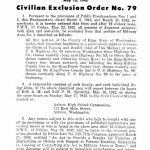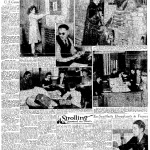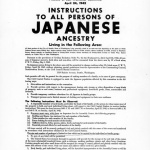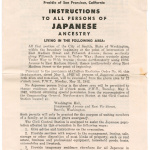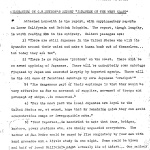John McCloy
| Name | John Snader McCloy |
|---|---|
| Born | March 31 1895 |
| Died | March 11 1989 |
| Birth Location | Philadelphia, PA |
Lawyer, corporate executive, and government official who played a large and mostly behind the scenes role in building the American foreign policy establishment over a sixty plus year period. During World War II, John J. McCloy (1895-1989) served as assistant secretary of war and was influential in brokering and subsequently defending the mass forced removal of Japanese Americans.
Early Life
John Snader McCloy was born in Philadelphia on March 31, 1895, to John Jay McCloy and Anna Snader McCloy and was the second of two sons. His father, a high school dropout, nonetheless rose to become an insurance company executive. In 1899, his older brother William died of diphtheria, and thirteen months later, his father died of a heart attack. Left without income, his mother became a hairdresser and her two unmarried sisters moved in with her. Young John would grow up in this household with the three women and would care for them for the rest of their lives.
With his mother's hairdressing business a success, John attended a mid-level private boarding school, the Peddie Institute in Hightstown, New Jersey, starting in 1907. He eventually became a good student and excelled in tennis. He went on to Amherst College in 1912, after changing his middle name to his father's. After his junior year in 1915, he was inspired to attend a World War I era military camp in Plattsburg, New York organized by elite business leaders that included an appearance by President Theodore Roosevelt. The doctrine of military preparedness and internationalism would remain with McCloy throughout his life. Upon his return to Amherst, he wrote a 2,000-word article for the school paper extolling the virtues of the camp. He graduated cum laude in 1916 and went back to Plattsburg in 1916 before going on to Harvard Law School.
With the war in Europe heating up, he took a break from his legal studies and returned to Plattsburgh in 1917, winning a commission as a field lieutenant. He became an aide-de-camp to Brigadier General Guy H. Preston, with whom he went to Europe, stationed in France for the last two months of the war and for the occupation period in Germany. Upon his graduation from Harvard Law School, he took a job in New York with the prestigious firm Cadwalader, Wickersham & Taft, where he came to specialize in railroad and antitrust cases. In 1924, after three years at Cadwalader, he moved to Cravath, Henderson & de Gersdorff, drawn by their banking and international clients.
Over the next fifteen years, McCloy would gain wealth, social standing, and a measure of fame as a Wall Street lawyer. He became nationally known for his role in two cases. The first was a reorganization of the St. Paul Railroad in 1925, assisted by future Supreme Court justice William O. Douglas, which was rife with what would now be called insider trading and which proved very profitable for the firm. The case also gained national press as a "symbol of Wall Street greed" [1] that ultimately was challenged in the Supreme Court. The second was the Black Tom case, which he spent over a decade on beginning in 1930. He represented American corporate clients seeking damages from the German government over a series of explosions in 1916 that destroyed munitions bound for Europe. McCloy's job—which he ultimately completed successfully—was to prove that the explosions were a result of German sabotage through a German American spy network.
His work at Cravath brought him wealth once he became a partner in 1929 and a managing partner in 1931. In 1930, he married Ellen Zinsser, and the couple had two children. Through his connections from Harvard and in various exclusive clubs in New York, he became well connected with the country's business and political elite, including his new brother-in-law, Lew Douglas, who became Franklin D. Roosevelt 's budget chief. Regarded as not particularly brilliant, but dogged, charismatic, and a consensus builder, he had risen from humble beginnings to a position of power.
World War II
McCloy's involvement with the War Department began with informal consultations with Secretary of War Henry Stimson in 1940 focused on the area of intelligence given McCloy's expertise in that area through his Black Tom experience. Taking on a larger role in various areas, he was named a special assistant to Stimson in December 1940, at which time he resigned from Cravath and moved with his family to Washington, D.C. He was named an assistant secretary of war in April 1941.
McCloy pushed for military readiness and concentration of executive powers in preparation for war. He was a key figure behind Lend-Lease legislation (which allowed the president to "lend" munitions to allies prior to the U.S. entering the war), intelligence issues (he advocated for and eventually brokered for a central intelligence apparatus that would become the Central Intelligence Agency (CIA)), and, once America entered the war, war strategy in Europe. He also unsuccessfully argued for legislation that would allow for wire-tapping, raising the ire of Attorney General Robert Jackson.
He was drawn into the brewing conflict over West Coast Japanese Americans between the army and War Department on one side and the Justice Department on the other. Sent by Stimson to represent the War Department at a February 1, 1942 meeting with army representatives Karl Bendetsen and Allen Gullion and Justice Department representatives James Rowe and Edward Ennis , McCloy served his usual mediator role. When Rowe and Gullion got into a heated argument, McCloy resolved the conflict by getting all to agree that they needed to get Western Defense Command head John DeWitt 's true assessment of the military necessity of removing Japanese Americans and suggested that the War Department would go along with it if DeWitt indeed favored it.
Two days later, he and Henry Stimson met Bendetsen and Gullion, with the latter pair presenting the former pair with DeWitt's "evidence" of communication between Japanese submarines and "Japanese spies." Later that day, McCloy spoke to DeWitt directly, with DeWitt first proposing a form of "voluntary evacuation" and McCloy countering with a proposal to remove everyone from militarily sensitive areas and "license" some to return. (Japanese Americans of course would not be licensed to return.) An urgent February 6 memo from Gullion arguing for "no half-way measures" seemed to be the final straw that convinced McCloy of Bendetsen's and Gullion's position.
On February 11, McCloy and Stimson talked to President Franklin D. Roosevelt directly and obtained his approval to proceed with mass removal of the Japanese Americans. McCloy immediately telephoned Bendetsen, giving him the good news from the President: "He says there will probably be some repercussions, but it has got to be dictated by military necessity, but as he puts it, 'Be as reasonable as you can.'" [2] Attorney General Francis Biddle soon acquiesced, ending the debate. McCloy was among those who helped craft the language of Executive Order 9066 , issued on February 19.
Through his work on the Black Tom case, McCloy was predisposed to believe wild reports of sabotage despite contrary evidence. (For instance, he had read the Munson Report and dismissed it as the work of "amateurs.") [3] His belief in total war also predisposed him to elide legal and constitutional issues when it came to matters that would aid the war effort, something he had demonstrated in his efforts to secure wiretapping legislation and prewar arms sales to allies. There is also evidence to suggest a more cynical rationale for his actions. In a July 1942, note to Undersecretary of War Robert Patterson, he wrote "These people are not 'internees'—they are under no suspicion for the most part and were moved largely because we felt we could not control our own white citizens in California." [4]
The exclusion and detention of Japanese Americans continued to take up much of his time. Many of his actions on this issue were geared towards buttressing the government's position for the coming constitutional showdown in the courts. In January 1943, he proposed forming a segregated Nisei unit in the army, which, along with segregation would show an honest attempt to determine "loyalty." In the spring of 1943, he had Karl Bendetsen re-write DeWitt's final report changing the assertion that it was "impossible" to tell the loyalty of the Japanese Americans to there being "no ready means existing for determining the loyal and the disloyal with any degree of safety" and withheld its release for a year. (See Final Report, Japanese Evacuation from the West Coast, 1942 .)
He also initiated the Japanese American Joint Board and pushed for not opening up the West Coast to Japanese Americans until after the 1944 election. Most notoriously, he fought to remove (then neuter) a footnote in the Korematsu Supreme Court brief inserted by Ennis and his deputy John Burling, in all probability saving the case. (Ennis and Burling's footnote disavowed claims of Japanese American espionage in DeWitt's final report. See Korematsu v. United States .)
With Stimson's health failing, McCloy began to take on more duties in running the War Department in the latter stages of the war. As reports of the Holocaust came in, he was disbelieving and made the fateful decision not to bomb railways to the death camps or the death camps themselves, reasoning that such action would divert military resources to a non-military issue. This decision likely resulted in deaths of tens of thousands additional Holocaust victims. McCloy argued for warning the Japanese about the atomic bomb and strenuously seeking a negotiated surrender and was troubled by its eventual use.
Postwar Power Broker
After the war, McCloy consolidated power and held a bewildering array of posts in the legal, financial, and governmental spheres from which he pursued American national interests and the interests of his corporate clients/employers as one and the same. Immediately after the war, he returned to practicing law for the renamed Milbank, Tweed, Hadley & McCloy. In 1947, he accepted an appointment as president of the World Bank and after two years, took a position as high commissioner of occupied Germany. He left Germany in July of 1952, and became president of Chase Bank, while also serving as a board member (and later chairman) of the Ford Foundation and chairman of the powerful Council on Foreign Relations starting in 1954. He also continued to advise President Dwight Eisenhower, serving on numerous commissions and being dispatched on official and unofficial foreign policy missions, a pattern that would recur to varying degrees with succeeding presidents into the 1980s. He also served on the boards of many major companies, including Westinghouse, AT&T, and Metropolitan Life. Under his leadership, he brokered the merging of Chase with Manhattan Bank to form Chase Manhattan Bank. He also oversaw the construction of One Chase Plaza in Wall Street starting in 1955.
He left Chase and returned to Milbank in 1960, where he chiefly represented the seven major oil companies, which required a special anti-trust exception from the Kennedy administration. At the same time, he served as Kennedy's disarmament czar and lead negotiator on missile withdrawal. After Kennedy's assassination, he served as a member of Warren Committee investigating the assassination.
Towards the end of his life, critics emerged of his role in World War II and in escalating the Cold War and building the postwar foreign policy establishment. One aspect of his long career that came under such criticism was his role in the Japanese American exclusion. He adamantly opposed redress and reparations in his appearance before the Commission on Wartime Relocation and Internment of Civilians and later told a friend, "Money, money, money. Why don't they dun the Japanese government? We didn't attack Pearl Harbor, they did." [5]
McCloy continued to play an active role in business and foreign policy into the Reagan administration. After a mild heart attack in 1982, he scaled back his activities and began preparing his memoirs, which were never finished. He died on March 11, 1989, just prior to his 94th birthday.
For More Information
Bird, Kai. The Chairman: John J. McCloy: The Making of the American Establishment . New York: Simon and Schuster, 1992.
Commission on Wartime Relocation and Internment of Civilians. Personal Justice Denied: Report of the Commission on Wartime Relocation and Internment of Civilians . Washington, D.C.: Government Printing Office, 1982. Foreword by Tetsuden Kashima. Seattle: University of Washington Press, 1997.
Daniels, Roger. Concentration Camps, North America: Japanese in the United States and Canada during World War II . Malabar, FL: Robert E. Krieger Publishing Co., 1981.
Irons, Peter. Justice at War: The Story of the Japanese American Internment Cases . New York: Oxford University Press, 1983.
Finding Aid to John J. McCloy Papers. Amherst College. http://asteria.fivecolleges.edu/findaids/amherst/ma35_main.html .
Robinson, Greg. “The McCloy Memo: A New Look at Japanese American Internment.” HHN , September 13, 2005. http://hnn.us/articles/15673.html
Robinson, Greg. A Tragedy of Democracy: Japanese Confinement in North America . New York: Columbia University Press, 2009.
World Bank. "John J. McCloy." http://web.worldbank.org/WBSITE/EXTERNAL/EXTABOUTUS/EXTARCHIVES/0,,contentMDK:20504728~pagePK:36726~piPK:437378~theSitePK:29506,00.html .
Footnotes
- ↑ Kai Bird. The Chairman: John J. McCloy: The Making of the American Establishment (New York: Simon and Schuster, 1992), 67.
- ↑ Roger Daniels, Concentration Camps, North America: Japanese in the United States and Canada during World War II (Malabar, FL: Robert E. Krieger Publishing Co., 1981), 65.
- ↑ Bird, The Chairman , 155.
- ↑ Cited in Greg Robinson, A Tragedy of Democracy: Japanese Confinement in North America , (New York: Columbia University Press, 2009), 102.
- ↑ Bird, The Chairman , 659.
Last updated April 17, 2024, 5:09 a.m..

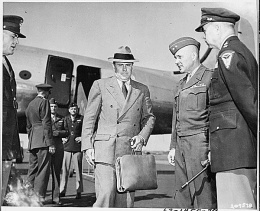 Media
Media
